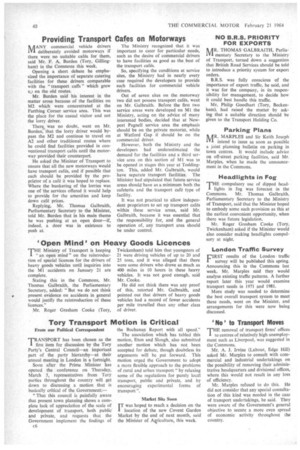Providing Transport Cafes on Motorways
Page 42

If you've noticed an error in this article please click here to report it so we can fix it.
lUIANY commercial vehicle drivers nu deliberately avoided motorways if there were no suitable cafés for them, said Mr. F. A. Burden (Tory, Gillingham) in the Commons this week.
Opening a short debate he emphasized the importance of separate catering facilities for these drivers comparable with the " transport calls" which grew u,) on the old routes. Mr. Burden said his interest in the matter arose because of the facilities on M2 which were concentrated at the Farthing Corner service area. This was the place for the casual visitor and not the lorry driver.
There was no doubt, went on Mr. Burden, that the lorry driver would bypass the M2 and continue to travel on A2 and other traditional routes where he could find facilities provided in conventional transport cafés until the motorway provided their counterpart.
He asked the Minister of Transport to ensure that all the new motorways would have transport cafés, and if possible that each should be provided by the proprietor of a café it was hoped to replace. Where the bunkering of the lorries was one of the services offered it would help to provide for the amenities and keep down café prices. Replying, Mr. Thomas Galbraith, Parliamentary Secretary to the Minister, told Mr. Burden that in his main theme he was pushing at an open door—if, indeed, a door was in existence to push at. The Ministry recognized that it was important to cater for particular needs, such as the desire of commercial drivers to have facilities as good as the best of the transport cafés. So, specifying the conditions at service sites, the Ministry had in nearly every case required the developers to provide such facilities for commercial vehicle drivers.
Out of seven sites on the motorway two did not possess transport cafés, went on Mr. Galbraith. Before the first two service areas were developed on MI the Ministry, acting on the advice of many interested bodies, decided that at Newport Pagnell service area the emphasis should be on the private motorist, while at Watford Gap it should be on the commercial driver.
However, both the Ministry and the developers had underestimated the demand for the facilities and a third service area on this section of Ml was to be opened in stages this year at Toddington. This, added Mr. Galbraith, would have separate transport facilities. The Minister had stipulated that future service areas should have as a minimum both the cafeteria and the transport cafe type of facility.
It was not practical to allow independent proprietors to set up transport cafés within these service areas, said Mr. Galbraith, because it was essential that the responsibility for, and the general operation of, any transport area should be under control.
























































































































